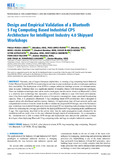Mostrar el registro sencillo del ítem
Design and empirical validation of a Bluetooth 5 fog computing based industrial CPS architecture for intelligent industry 4.0 shipyard workshops
| dc.creator | Fraga Lamas, Paula | es_ES |
| dc.creator | López Iturri, Peio | es_ES |
| dc.creator | Celaya Echarri, Mikel | es_ES |
| dc.creator | Blanco Novoa, Óscar | es_ES |
| dc.creator | Azpilicueta Fernández de las Heras, Leyre | es_ES |
| dc.creator | Varela Barbeito, José | es_ES |
| dc.creator | Falcone Lanas, Francisco Javier | es_ES |
| dc.creator | Fernández Caramés, Tiago M. | es_ES |
| dc.date.accessioned | 2020-08-05T06:00:29Z | |
| dc.date.available | 2020-08-05T06:00:29Z | |
| dc.date.issued | 2020 | |
| dc.identifier.citation | P. Fraga-Lamas et al., 'Design and Empirical Validation of a Bluetooth 5 Fog Computing Based Industrial CPS Architecture for Intelligent Industry 4.0 Shipyard Workshops,' in IEEE Access, vol. 8, pp. 45496-45511, 2020, doi: 10.1109/ACCESS.2020.2978291. | en |
| dc.identifier.issn | 2169-3536 | |
| dc.identifier.uri | https://hdl.handle.net/2454/37662 | |
| dc.description.abstract | Navantia, one of largest European shipbuilders, is creating a fog computing based Industrial Cyber-Physical System (ICPS) for monitoring in real-time its pipe workshops in order to track pipes and keep their traceability. The deployment of the ICPS is a unique industrial challenge in terms of communications, since in a pipe workshop there is a significant number of metallic objects with heterogeneous typologies. There are multiple technologies that can be used to track pipes, but this article focuses on Bluetooth 5, which is a relatively new technology that represents a cost-effective solution to cope with harsh environments, since it has been significantly enhanced in terms of low power consumption, range, speed and broadcasting capacity. Thus, it is proposed a Bluetooth 5 fog computing based ICPS architecture that is designed to support physically-distributed and low-latency Industry 4.0 applications that off-load network traffic and computational resources from the cloud. In order to validate the proposed ICPS design, one of the Navantia's pipe workshops was modeled through an in-house developed 3D-ray launching radio planning simulator that allows for estimating the coverage provided by the deployed Bluetooth 5 fog computing nodes and Bluetooth 5 tags. The experiments described in this article show that the radio propagation results obtained by the simulation tool are really close to the ones obtained through empirical measurements. As a consequence, the simulation tool is able to reduce ICPS design and deployment time and provide guidelines to future developers when deploying Bluetooth 5 fog computing nodes and tags in complex industrial scenarios. | en |
| dc.description.sponsorship | This work was supported in part by the Auto-ID for Intelligent Products research line of the Navantia-UDC Joint Research Unit under Grant IN853B-2018/02, and in part by the Ministerio de Ciencia, Innovación y Universidades, Gobierno de España (MCIU/AEI/FEDER,UE) under Grant RTI2018-095499-B-C31. | en |
| dc.format.extent | 16 p. | |
| dc.format.mimetype | application/pdf | en |
| dc.language.iso | eng | en |
| dc.publisher | IEEE | en |
| dc.relation.ispartof | IEEE Access, 2020, vol. 8, 45496-45511 | en |
| dc.rights | This work is licensed under a Creative Commons Attribution 4.0 License. | en |
| dc.rights.uri | http://creativecommons.org/licenses/by/4.0/ | |
| dc.subject | Industry 4.0 | en |
| dc.subject | IIoT | en |
| dc.subject | Cyber-physical system | en |
| dc.subject | ICPS | en |
| dc.subject | Fog computing | en |
| dc.subject | Edge computing | en |
| dc.subject | Shipyard 4.0 | en |
| dc.subject | Bluetooth 5 | en |
| dc.subject | LP-WAN | en |
| dc.subject | 3D ray launching | en |
| dc.title | Design and empirical validation of a Bluetooth 5 fog computing based industrial CPS architecture for intelligent industry 4.0 shipyard workshops | en |
| dc.type | info:eu-repo/semantics/article | en |
| dc.type | Artículo / Artikulua | es |
| dc.contributor.department | Ingeniería Eléctrica, Electrónica y de Comunicación | es_ES |
| dc.contributor.department | Ingeniaritza Elektrikoa, Elektronikoa eta Telekomunikazio Ingeniaritza | eu |
| dc.contributor.department | Institute of Smart Cities - ISC | es_ES |
| dc.rights.accessRights | info:eu-repo/semantics/openAccess | en |
| dc.rights.accessRights | Acceso abierto / Sarbide irekia | es |
| dc.identifier.doi | 10.1109/ACCESS.2020.2978291 | |
| dc.relation.projectID | info:eu-repo/grantAgreement/AEI/Plan Estatal de Investigación Científica y Técnica y de Innovación 2017-2020/RTI2018-095499-B-C31/ES/ | en |
| dc.relation.publisherversion | https://doi.org/10.1109/ACCESS.2020.2978291 | |
| dc.type.version | info:eu-repo/semantics/publishedVersion | en |
| dc.type.version | Versión publicada / Argitaratu den bertsioa | es |



